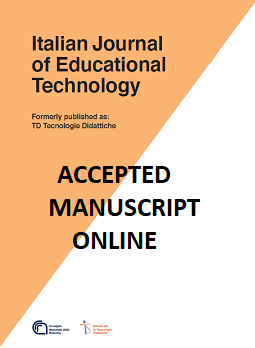Production of a cognitive virtual reality artefact in the teaching of the History of Structural Engineering
Main Article Content
Abstract
T
The article analyses the use of virtual (VR) and augmented reality (AR) in the teaching of History of Construction at the University of Rome Tor Vergata, during the academic year (AY) 2024/25. The students designed three-dimensional experiences to explore architectural structures and understand their construction characteristics. The project integrated AR/VR as tools for constructing cognitive artefacts, evaluated in itinere. Through a case study and the analysis of a questionnaire, the links between the teaching task and the support of the learning process are explored, in particular: 1) the activation of pre-knowledge; 2) the use of metacognitive strategies, including deliberate practice and self-explanation; 3) the ability to map and verbalize learned knowledge. The results highlight the effectiveness of AR/VR in constructing epistemic representations and promoting meta-reflections in design learning processes.
Article Details

This work is licensed under a Creative Commons Attribution 4.0 International License.
Authors who publish with this journal agree to the following terms:
- Authors retain copyright and grant the journal right of first publication with the work simultaneously licensed under a Creative Commons CC BY 4.0 Attribution 4.0 International License.
- Authors are able to enter into separate, additional contractual arrangements for the non-exclusive distribution of the journal's published version of the work (e.g., post it to an institutional repository or publish it in a book), with an acknowledgement of its initial publication in this journal.
- Authors are permitted and encouraged to post their work online (e.g., in institutional repositories or on their website) prior to and during the submission process, as it can lead to productive exchanges, as well as earlier and greater citation of published work (See The Effect of Open Access)
References
Ausubel, D. P. (1978). Educazione e processi cognitivi. Guida psicologica per gli insegnanti. Franco Angeli.
Coban, M., Bolat, Y. I., & Goksu, I. (2022). The potential of immersive virtual reality to enhance learning: A meta-analysis. Educational Research Review, 36, Article 100452. https://doi.org/10.1016/j.edurev.2022.100452
Dávila Delgado, J. M., Oyedele, L., Demian, P., & Beach, T. (2020). A research agenda for augmented and virtual reality in architecture, engineering and construction. Advanced Engineering Informatics, 45, 101122. https://doi.org/10.1016/j.aei.2020.101122
de la Torre Acha, A. I., Belver, R. M. R., Aguirrebeña, F. J., & Merlo, C. (2024). Application of simulation and virtual reality to production learning. Education + Training, 66(2–3), 145–165. https://doi.org/10.1108/ET-02-2023-0051
Hattie, J., & Yates, G. C. R. (2013). Visible learning and the science of how we learn. Routledge.
Ibrahim, A., Al-Rababah, A. I., & Bani Baker, Q. (2021). Integrating virtual reality technology into architecture education: The case of architectural history courses. Open House International, 46(3), 498–509. https://doi.org/10.1108/OHI-12-2020-0190
Iori, T. (2017). L’apoteosi del Sistema Nervi. Il Palazzetto dello sport. In T. Iori & S. Poretti (Eds.), SIXXI 4. Storia dell’ingegneria strutturale in Italia (pp. 66–75). Gangemi.
Iori, T., & Poretti, S. (2016). Storia dell’ingegneria strutturale italiana. Ascesa e declino. In T. Iori & S. Poretti (Eds.), La Scuola italiana di ingegneria. Rassegna di architettura e urbanistica, 148 (pp. 8–52). Gangemi.
Kaur, D. P., Kumar, A., Dutta, R., & Malhotra, S. (2022). The role of interactive and immersive technologies in higher education: A survey. Journal of Engineering Education Transformations, 36(2), 79–86. https://doi.org/10.16920/jeet/2022/v36i2/157224
Lanzo, J. A., Valentine, A., Sohel, F., Yapp, A. Y. T., Muparadzi, K. C., & Abdelmalek, M. (2020). A review of the uses of virtual reality in engineering education. Computer Applications in Engineering Education, 28(3), 748–763. https://doi.org/10.1002/cae.22243
Marzano, R. J., Pickering, D. J., & Pollock, J. (2001). Classroom instruction that works: Research-based strategies for increasing student achievement. ASCD.
Merriam, S. B. (2009). Qualitative research: A guide to design and implementation. John Wiley & Sons.
Nesbit, J. C., & Adesope, O. O. (2006). Learning with concept and knowledge maps: A meta-analysis. Review of Educational Research, 76(3), 413–448. https://doi.org/10.3102/00346543076003413
Poretti, S., Iori, T., et al. (2017). Il Sistema Nervi e il Palagioco. In G. Barazzetta (Ed.), Pier Luigi Nervi. Il modello come strumento di progetto e costruzione (pp. 81–103). Quodlibet.
Preiss, R. W., & Gayle, B. M. (2006). A meta-analysis of the educational benefits of employing advanced organizers. In B. M. Gayle, R. W. Preiss, N. Burrell, & M. Allen (Eds.), Classroom communication and instructional processes: Advances through meta-analysis (pp. 329–344). Lawrence Erlbaum Associates.
Rivoltella, P. C. (2012). Neurodidattica: Insegnare al cervello che apprende. Raffaello Cortina.
Sakr, A., & Abdullah, T. (2024). Virtual, augmented reality and learning analytics impact on learners, and educators: A systematic review. Education and Information Technologies, 29, 19913–19962. https://doi.org/10.1007/s10639-024-12602-5
Wertsch, J. V. (1998). Mind as action. Oxford University Press.
Wu, B., Yu, X., & Gu, X. (2020). Effectiveness of immersive virtual reality using head-mounted displays on learning performance: A meta-analysis. British Journal of Educational Technology, 51(6), 1991–2005. https://doi.org/10.1111/bjet.13023
Yung, R., & Khoo-Lattimore, C. (2017). New realities: A systematic literature review on virtual reality and augmented reality in tourism research. Current Issues in Tourism, 22(17), 2056–2081. https://doi.org/10.1080/13683500.2017.1417359
Zontou, E., Kaminaris, S., & Rangoussi, M. (2024). On the role of virtual reality in engineering education: A systematic literature review of experimental research (2011–2022). European Journal of Engineering Education, 49(5), 856–888. https://doi.org/10.1080/03043797.2024.2369188

